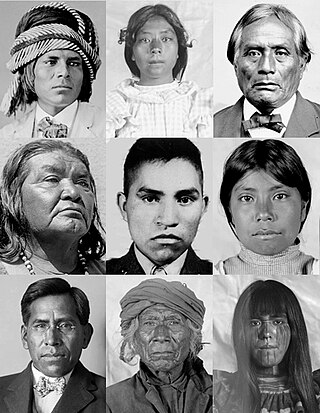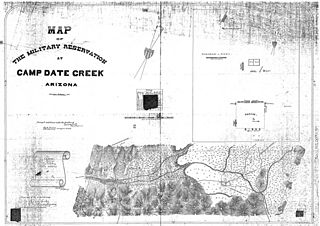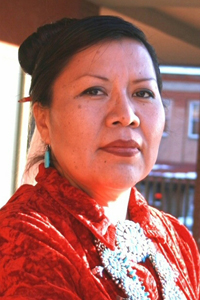Related Research Articles

Coconino County is a county in the north-central part of the U.S. state of Arizona. Its population was 145,101 at the 2020 census. The county seat is Flagstaff. The county takes its name from Cohonino, a name applied to the Havasupai people. It is the second-largest county by area in the contiguous United States, behind San Bernardino County, California. It has 18,661 sq mi (48,300 km2), or 16.4% of Arizona's total area, and is larger than each of the nine smallest states in the U.S.

The Akimel O'odham, also called the Pima, are a group of Native Americans living in an area consisting of what is now central and southern Arizona, as well as northwestern Mexico in the states of Sonora and Chihuahua. The majority population of the two current bands of the Akimel O'odham in the United States are based in two reservations: the Keli Akimel Oʼodham on the Gila River Indian Community (GRIC) and the On'k Akimel O'odham on the Salt River Pima-Maricopa Indian Community (SRPMIC).
Indigenous peoples of Arizona are the Native American people of the state of Arizona. These include people that have lived in the region since time immemorial; tribes who entered the region centuries ago, such as the Southern Athabascan peoples; and the Pascua Yaqui who settled Arizona in mass in the early 20th century, though small communities had been in the region for hundreds of years prior.

The Western Apache live primarily in east central Arizona, in the United States and north of Mexico in the states of Sonora and Chihuahua. Most live within reservations. The Fort Apache Indian Reservation, San Carlos Apache Indian Reservation, Yavapai-Apache Nation, Tonto Apache, and the Fort McDowell Yavapai Nation are home to the majority of Western Apache and are the bases of their federally recognized tribes. In addition, there are numerous bands. The Western Apache bands call themselves Ndee (Indé). Because of dialectical differences, the Pinaleño/Pinal and Arivaipa/Aravaipa bands of the San Carlos Apache pronounce the word as Innee or Nnēē:.

The Tonto Apache is one of the groups of Western Apache people and a federally recognized tribe, the Tonto Apache Tribe of Arizona. The term is also used for their dialect, one of the three dialects of the Western Apache language.

The Hualapai is a federally recognized Native American tribe in Arizona with about 2300 enrolled members. Approximately 1353 enrolled members reside on the Hualapai Reservation, which spans over three counties in Northern Arizona.

Frybread is a dish of the indigenous people of North America that is a flat dough bread, fried or deep-fried in oil, shortening, or lard.
Arizona's 2nd congressional district is a congressional district located in the U.S. state of Arizona. The district is in the north eastern part of the state and includes Apache, Coconino, Gila, Navajo, and Yavapai counties in their entirety and portions of Graham, Maricopa, Mohave, and Pinal counties. The largest city in the district is Flagstaff.

Oasisamerica is a term that was coined by Paul Kirchhoff and published in a 1954 article, and is used by some scholars, primarily Mexican anthropologists, for the broad cultural area defining pre-Columbian southwestern North America. It extends from modern-day Utah down to southern Chihuahua, and from the coast on the Gulf of California eastward to the Río Bravo river valley. Its name comes from its position in relationship with the similar regions of Mesoamerica and mostly nomadic Aridoamerica. The term Greater Southwest is often used to describe this region by American anthropologists.

The Apache Scouts were part of the United States Army Indian Scouts. Most of their service was during the Apache Wars, between 1849 and 1886, though the last scout retired in 1947. The Apache scouts were the eyes and ears of the United States military and sometimes the cultural translators for the various Apache bands and the Americans. Apache scouts also served in the Navajo War, the Yavapai War, the Mexican Border War and they saw stateside duty during World War II. There has been a great deal written about Apache scouts, both as part of United States Army reports from the field and more colorful accounts written after the events by non-Apaches in newspapers and books. Men such as Al Sieber and Tom Horn were sometimes the commanding officers of small groups of Apache Scouts. As was the custom in the United States military, scouts were generally enlisted with Anglo nicknames or single names. Many Apache Scouts received citations for bravery.

The Yavapai are a Native American tribe in Arizona. Historically, the Yavapai – literally “people of the sun” – were divided into four geographical bands who identified as separate, independent peoples: the Ɖulv G’paaya, or Western Yavapai; the Yaavpe', or Northwestern Yavapai; the Gwev G’paaya, or Southeastern Yavapai; and the Wiipukpaa, or Northeastern Yavapai – Verde Valley Yavapai.

The Hualapai War, or Walapai War, was an armed conflict fought from 1865 to 1870 between the Hualapai native Americans and the United States in Arizona Territory. The Yavapai also participated on the side of the Hualapai and Mohave scouts were employed by the United States Army. Following the death of the prominent Yavapai leader Anasa in April 1865, the natives began raiding American settlements which provoked a response by the United States Army forces stationed in the area. By the spring of 1869 disease forced the majority of the Hualapais to surrender though some skirmishing continued for almost two more years.
The Fry Bread House is a restaurant in Phoenix, Arizona, serving fry bread, a Native American dish of dough fried in lard, Crisco, or oil, which the restaurant serves with various toppings or fillings. Exact recipes and ingredients vary but those typical of frybread are flour, salt, and lard, reflecting the commodities doled out on the reservations by the U.S. federal government.

The Schoolhouse at Truxton Canyon Training School, which has also been known as the Truxton Canyon Indian School and as the Valentine Indian School, is a historic schoolhouse that was built in 1903. It was built using Colonial Revival architecture as a work of the Office of Indian Affairs, and was expanded, compatibly with the Colonial Revival style, in 1929. It was listed on the National Register of Historic Places in 2003.

Jamescita Mae Peshlakai is a former Democratic member of the Arizona State Senate, serving from 2017 to 2021. She previously served in the Arizona House of Representatives from 2013 until 2015, and served as co-Minority Whip for the 2018 sitting of the state senate. Peshlakai is a member of the Navajo Nation. She served in the Persian Gulf War. Before her legislative service, Peshlakai provided agricultural outreach to Native Americans on behalf of the USDA.
Tatanka Wanbli Sapa Xila Sabe Means is a Native American activist, actor, boxer, comedian, and entrepreneur of Oglala Lakota, Omaha, Yankton Dakota and Diné descent. He is best known for his roles in Saints & Strangers and Tiger Eyes.

The Indigenous peoples of the North American Southwest are those in the current states of Colorado, Arizona, New Mexico, Utah, and Nevada in the western United States, and the states of Sonora and Chihuahua in northern Mexico. An often quoted statement from Erik Reed (1964) defined the Greater Southwest culture area as extending north to south from Durango, Mexico to Durango, Colorado and east to west from Las Vegas, Nevada to Las Vegas, New Mexico. Other names sometimes used to define the region include "American Southwest", "Northern Mexico", "Chichimeca", and "Oasisamerica/Aridoamerica". This region has long been occupied by hunter-gatherers and agricultural people.
References
- ↑ "'More Than Frybread': Native American mockumentary fries up fun". AXS. Retrieved 2016-12-20.
- ↑ "More Than FryBread". navajotimes.com. Retrieved 2016-12-19.
- ↑ "'More Than Frybread'". azcentral.com. Retrieved 2016-12-20.
- ↑ Goodykoontz, Bill. "'Frybread' overdone: Native fun wears thin". Arizona Republic. Phoenix, Arizona. pp. P1, P2. Retrieved 1 October 2019.
- ↑ Hamilton, Travis Holt; Apachee, Deshava; Apachee, Jesse S.; Arviso, Ojay (2012-02-03), More Than Frybread , retrieved 2016-12-20
- ↑ Vantrease (2013). "Commod bods and frybread power. Government food aid in American Indian culture". Journal of American Folklore. 126 (499): 55–59. doi:10.5406/jamerfolk.126.499.0055. S2CID 161943946.
- ↑ "More Than Frybread". Holt Hamilton Films. Retrieved 2016-12-19.
- ↑ "More Than Frybread Mockumentary Going Rez to Rez - Indian Country Media Network". Indian Country Media Network. 2012-03-25. Retrieved 2016-12-20.
- ↑ Fellow, April Sperry Entertainment; Post, The Huffington (2014-02-13). "Could 'Frybread' Become America's First Native American Sitcom?". The Huffington Post. Retrieved 2016-12-20.